Health education 07: Cells in our blood
We all know that our body is made up of millions of cells of various kinds. Today let us know about the cells in our blood.
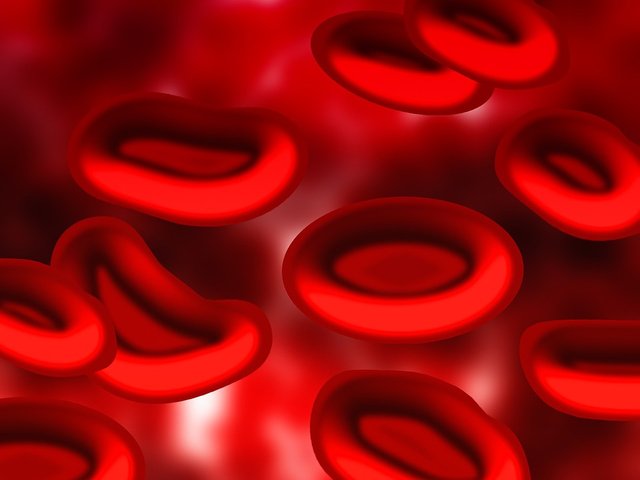
image from Pixabay
In the blood, there are 3 types of cells circulating throughout our body;
- Red Blood Cell (RBC) or Erythrocyte
- White blood cell (WBC) or Leucocytes, and
- Platelets or thrombocyte
RBCs:
- RBCs are produced in the bone marrow (BM) which transport oxygen (and carbon dioxide)
- Following ingredients are required for the formation of a red cell:-
■ Metals: Iron, cobalt, manganese
■ Vitamins: B12, B6, C, E, Folate, riboflavin, pantothenic acid, thiamine
■ Amino acid
- It is biconcave in shape with the diameter of 7.2-8.4 µm. It contains mostly Hemoglobin (Hb).
- Mature RBCs don’t have any nucleus, hence they can’t synthesize protein

[Image of a single RBC, from the "ABC of CBC" book] - It can survive 120 days
- We count RBCs (along with Hb %) to detect if a patient is having anemia or not. Clinically it tells us about the oxygen carrying capacity of the blood
- The numbers of RBCs vary according to age, sex, altitude, kidney functions and other factors. Here are the normal ranges of RBCs (According to age and sex)
■ In Newborn: 4.1-6.1 million cells/ mm3
■ In Children: 3.6-5.5 million cells/ mm3
■ Adult male: 4.6-6.0 million cells/ mm3
■ Adult female: 4.2-5.0 million cells/ mm3
■ During pregnancy: Slightly lower than normal adult value
Platelets:
- They are the smallest among the blood cell groups
- Another name is thrombocytes. Thrombo means Clot. They help in clot formation. If there is any injury which involves blood vessels (e.g. cut injury), the platelets come into action, make a clot, plug the injured site and stop the bleeding. The process is called hemostasis.
- The above mentioned hemostasis process sometimes may bring undesirable effects in our body (due to certain disease conditions) and results in MI, Strokes, DIC like life threatening crisis.
- They are produced from very large cells group in the BM. These large cells are called megakaryocytes. Platelets are nothing but the fragmented cytoplasm of megakaryocytes. One megakaryocyte produces around 4000 platelets.
- Like RBCs, they don’t have any nucleus.

Image of megakaryocytes and platelets, from the book named as "ABC of CBC"
- Normal diameter of a platelet is 1-3 µm and life span is 9-12 days
- Normal counts of platelets are 150000-450000 cells/µL
WBCs
- They contain nucleus
- They are the cells of our body immune system and constantly fighting against various infectious agents and foreign materials
- Normal counts vary according to age:
■ At birth: 4000-40000 cells/ mm3
■ At 4 years of age: 5000-15000 cells/ mm3
■ Adults: 4000-11000 cells/mm3
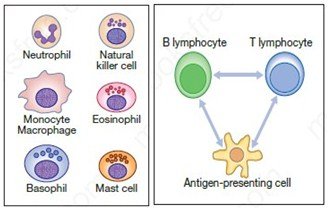
The cells of WBC series
- Depending upon the shape of the nucleus, presence of granules in the cytoplasm and nature of activities, WBCs are divided into following types:
1. Granulocytes (polymorphonuclear leukocytes): they contain granular components in their cytoplasm which are actually sacks of enzymes. Their nucleus may be segmented or morphologically different
- Neutrophils
- Basophils
- Eosinophils
2. Agranulocytes (mononuclear leukocytes): Apparently don’t have granular components (but it is not actually corrects) and they have single, round nucleus.
- Lymphocytes: It is again divided into T lymphocyte and B lymphocyte. (See below)
- Monocytes/Macrophage(See below)
3. Specialized WBCs:
Dendritic cells: They are one type of Antigen presenting cells (APCs) of the immune system and produced from the same precursor cells that of polymorphoneuclear leukocytes which is known as myeloid precursor cells. Later they differentiate into a quite different cell type known as dendritic cell. They are abundantly present in those tissues which are in contact with outer environments or foreign substance. That means dendritic cells are found mostly in the skin, inner lining of nose, lungs, stomach and intestines. In the skin they are specialized form of dendritic cells are found known as Langerhans cells. They monitor the surrounding tissue environment for microbes and foreign particles. When they find one, they become active; carry the microbes to the nearly regional lymph node and present to the higher authority (T and B lymphocytes).
Natural killer (NK) cells: They are large granular lymphocytes. It’s major role in defense against tumors and viruses. They have special ability to be angry with (activate) those cells which are damaged or invaded by microbes. It can kill their target cells by making a hole into their cell membrane (target cell) and pouring proteolytic enzymes known as granzymes into the cell. As a result the target cells become dead eventually; the process here is known as apoptosis.
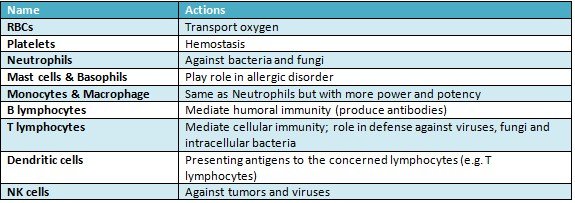
The above table shows different blood cells with their principal actions
Some additional things we need to in this perspective:
Monocytes and macrophage:
Monocytes circulate within blood along with other cells and they are produced in the bone marrow. Later, they leave the circulation and enter into peripheral tissues where they differentiate and become macrophage. Depending upon the sites, the macrophage is called as different name. In liver they are known as Kupffer cells, in the lung tissues they are called alveolar macrophage, in the kidney they are termed as mesangial cells, and in the brain as microgial cells. Where ever they are, their functions are exactly same.
Antigen presenting cells (APC): These are a group of immune cells of our body which are responsible for mediating cellular immunity by catching, processing and presenting antigens or microbes to concerned lymphocytes e.g. T lymphocytes. The professional APCs are dendritic cells (and Langerhans cells), macrophage and B cells (B lymphocytes)
CD4+ cells: If you read something on HIV/AIDS, you may come to know a term which is CD4 cells (or CD4+ cells). What are they? They are nothing but WBCs which contain a special protein (glycoprotein) on their cell member known as CD4 (CD stand for cluster of differentiation). T-helper lymphocytes, monocyte-macrophage and dendritic cells are included in the list. This is particularly important in context with HIV/AIDS.
The Cells in our blood in a single picture
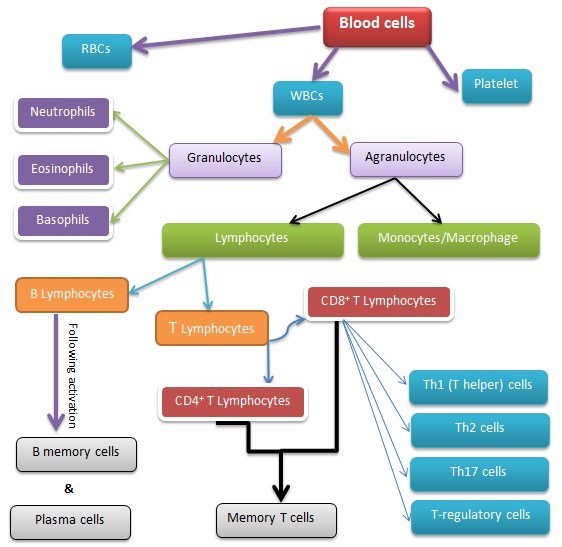
Reference:
- The ABC of CBC: Interpretation of Complete Blood Count and
Histograms; page: 6 - Davidson's Principles and Practice of Medicine 23rd Edition; page: 62
Presents Useful Medical Questions and Answers for medical personals
Posted from myAirClinic Healthcare App. Download Android App on Google PLAYSTORE!
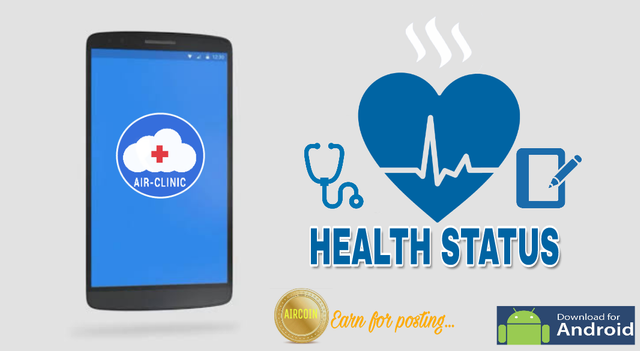.png)
Hi @hafiz34!
Your post has been upvoted by @bdcommunity.
You can support us by following our curation trail or by delegating SP to us.
20 SP, 50 SP, 100 SP, 300 SP, 500 SP, 1000 SP.
If you are not actively voting for Steem Witnesses, please set us as your voting proxy.
Feel free to join BDCommunity Discord Server.
Wow am nose-bleeding with all these terms
Posted using Partiko Android
Yes. I agree. Some terms are tough for non-medical person but I had to make this post. Because, in my subsequent post on HIV/AIDS , these terms will appear.
You got a 96.77% upvote from @bdvoter courtesy of @hafiz34!
Delegate your SP to us at @bdvoter and earn daily 100% profit share for your delegation & rewards will be distributed automatically daily.
500 SP, 1000 SP, 2500 SP, 5000 SP, 10000 SP.
If you are from Bangladesh and looking for community support, Join BDCommunity Discord Server & If you want to support our service, please set your witness proxy to BDCommunity.